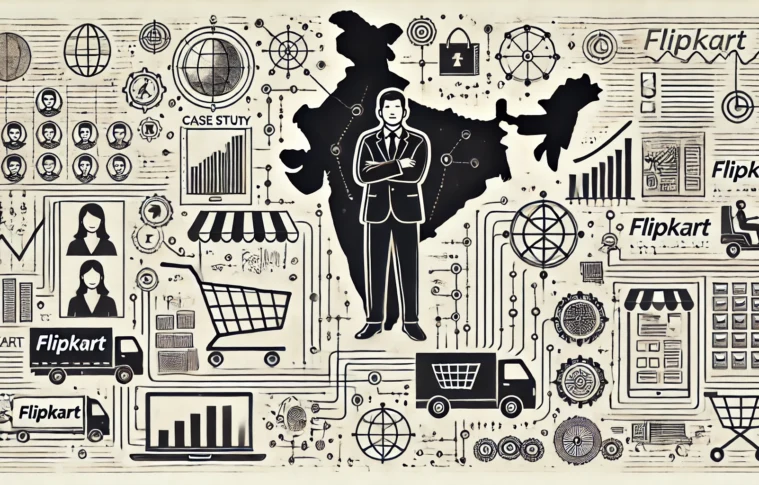1. Introduction
Founded in 2007, Flipkart is one of the most prominent e-commerce platforms in India, revolutionizing how consumers shop online. The company started with the goal of transforming the online retail space by offering a seamless and convenient shopping experience. Flipkart was acquired by Walmart in 2018, solidifying its role as a global player in e-commerce.
Flipkart has successfully capitalized on India’s growing internet penetration, consumer demand for online shopping, and technological innovation. This case study explores the business model of Flipkart, its strategies, competitive positioning, revenue streams, and operational success.
2. Company Overview
- Founded: 2007
- Headquarters: Bangalore, India
- Acquired by Walmart: 2018 for $16 billion
- Sector: E-commerce/Retail
- Core Business: Online marketplace for consumer electronics, fashion, groceries, and more.
Flipkart’s initial journey began with selling books online, which was followed by expanding into electronics, clothing, and daily essentials. Over time, Flipkart became a comprehensive marketplace, competing with other Indian e-commerce giants such as Amazon India and Snapdeal.
3. Business Model of Flipkart
The business model of Flipkart is a mix of marketplace operations, logistics capabilities, technological innovation, and strategic partnerships. Below are the core components of its business model:
A. Marketplace Business Model
Flipkart operates primarily as a marketplace model, connecting buyers and sellers on a single platform. It allows third-party sellers to list their products on the platform while Flipkart acts as an intermediary facilitating transactions.
How It Works:
- Sellers List Products: Flipkart allows vendors (small sellers, large brands, or distributors) to create seller accounts and list their products on the platform.
- Customer Purchase: Customers browse the platform and purchase products directly from sellers via Flipkart.
- Transaction Fees: Flipkart takes a commission from each sale made on its platform.
B. Revenue Streams
Flipkart generates revenue through diversified streams:
- Commission Fees: A percentage of each sale made by third-party sellers on the platform. This is the primary revenue driver for Flipkart.
- Logistics Fees: Flipkart operates its logistics arm, eKart, and charges sellers for shipping, handling, and other supply chain services.
- Advertising Fees: Brands and sellers pay Flipkart to feature their products prominently on search results and landing pages.
- Private Labels & Exclusive Offerings: Flipkart invests in private brands and exclusive product partnerships, enabling additional revenue generation.
- Subscription Services: Similar to Amazon Prime, Flipkart has explored subscription-based models, offering benefits like expedited shipping or exclusive offers.
4. Key Strategies that Drive Flipkart’s Business Model
Flipkart’s ability to become a dominant player in the Indian e-commerce market can be attributed to its strategic focus on technology, supply chain infrastructure, and customer acquisition.
1. Technology & Platform Experience
Flipkart has invested significantly in technology to offer seamless user experiences, including:
- A user-friendly interface and personalized recommendations through data analytics.
- Advanced search and AI capabilities to enhance product discovery and personalized shopping.
2. Logistics & Supply Chain Network
Flipkart operates its logistics subsidiary eKart, which has allowed the company to maintain fast delivery timelines (next-day delivery in most cases). eKart’s efficient supply chain and partnerships with local couriers ensure that Flipkart can deliver even to remote locations.
3. Seller Ecosystem Development
Flipkart has empowered thousands of small- and medium-sized businesses (SMBs) by allowing them to list their products on the platform. Flipkart provides these sellers with tools and support to scale up their operations, including warehousing, supply chain support, and payment gateway integration.
4. Strategic Partnerships & Investments
Acquired by Walmart in 2018, Flipkart has strengthened its supply chain, technology, and market reach through collaborations with global players.
5. Private Labels & Exclusive Product Lines
Flipkart has launched its private brands across categories like fashion, electronics, and daily essentials. These exclusive product lines have helped Flipkart increase profitability by cutting costs and differentiating itself from competitors.
5. Competitive Advantage
Flipkart maintains a strong competitive edge over other e-commerce players in India through several strategic advantages:
- Local Market Adaptability: Flipkart understood the nuances of the Indian market early on, from consumer behaviors to logistics challenges, adapting its strategies accordingly.
- Strong Supply Chain: The development of eKart, its logistics network, ensures timely delivery and operational excellence.
- Seller Empowerment: By supporting small sellers and offering easy access to tools and financing, Flipkart has created a wide range of products on its platform.
- Customer-Centric Approach: Flipkart invests in customer trust by offering easy return policies, competitive pricing, and a variety of payment options, including cash-on-delivery (COD), catering to less banked users.
6. Challenges Faced
While Flipkart has been successful, it has encountered challenges that have shaped its operations:
1. Intense Competition
Flipkart competes with global e-commerce giants like Amazon India and local players like Snapdeal. Both competitors have heavily invested in acquiring market share, forcing Flipkart to innovate continuously.
2. Regulatory Environment
E-commerce in India is subject to government policies and regulations. Flipkart has had to adapt to changes in tax policies and foreign investment laws to maintain compliance.
3. Logistics & Delivery Challenges
Serving India’s diverse and remote geography has created challenges related to delivery timelines and supply chain management. Flipkart has overcome these through infrastructure investments in eKart.
4. Profitability Pressures
Despite its vast market presence, profitability remains a challenge for Flipkart due to thin margins, advertising costs, technology investments, and operational expenses.
7. Results and Metrics
Flipkart has shown tremendous growth in market share and technological advancements since its inception.
Key Metrics:
- Users: Over 400+ million active users in India.
- Market Share: 40%-50% of the Indian e-commerce market share.
- Annual Revenue: Walmart reported $6 billion in annual revenue from Flipkart (as of 2021 estimates).
- Seller Network: More than 500,000+ registered sellers across India.
Flipkart’s innovative business model and strategic investments have resulted in continuous growth, technological adoption, and diversification.
8. Lessons from Flipkart’s Business Model
1. Diversify Revenue Streams
Flipkart didn’t rely solely on transaction fees; they expanded into logistics, advertising, and private labels to ensure multiple revenue pathways.
2. Technology as a Differentiator
Personalized shopping through AI, intuitive UX, and personalized recommendations solidified customer loyalty.
3. Addressing Market Needs with Logistics
An efficient supply chain and last-mile delivery system can significantly enhance consumer satisfaction and loyalty.
4. Adaptability is Key
Adapting to local market nuances and consumer behaviors has given Flipkart a competitive edge.
9. Conclusion
Flipkart’s business model is a prime example of how a mix of technology, logistics, marketplace strategies, and innovation can create a thriving e-commerce platform. Its strategic moves such as leveraging AI, investing in supply chain infrastructure, and integrating private labels and strategic partnerships allowed Flipkart to build its leadership position in the Indian market.
Although it faces challenges like competition and market changes, Flipkart’s focus on strategic growth and customer-centricity ensures its role as an e-commerce giant in India and beyond.
Flipkart serves as a testament to how innovative thinking, combined with technological investments and market understanding, can lead to building a business model that scales and sustains growth.
Disclaimer
Posts in the Notebook are written by individual members and reflect personal insights or opinions. Please verify any information independently. If you have any concerns, notify the admin immediately so we can take action before any legal steps are taken.





